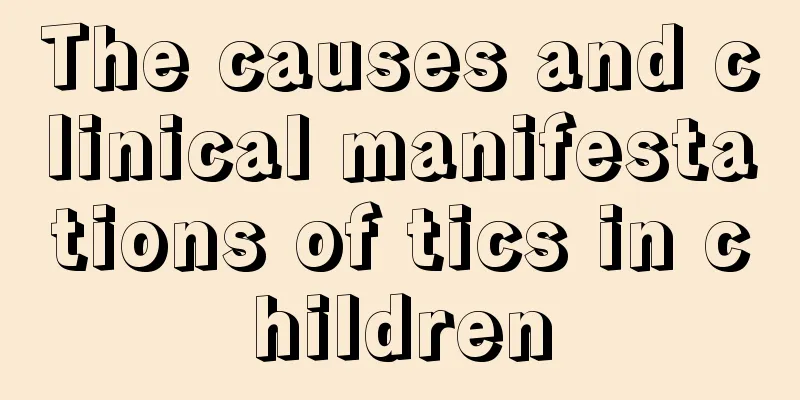The causes and clinical manifestations of tics in children

|
Childhood tics will appear in some children, so parents must be very worried at this time. So how much do you know about the conditions related to childhood tics? We say that we cannot ignore this situation, so the editor below would like to introduce the causes and clinical manifestations of childhood tics to you. If you want to know the specific situation, let's take a look! 1. Causes The occurrence of this disease is mainly related to the following factors. 1. Genetics Studies have confirmed that genetic factors are associated with the occurrence of Tourette syndrome, but the mode of inheritance is unclear. Family surveys found that 10% to 60% of patients had a positive family history. Twin studies confirmed that the concordance rate of monozygotic twins (75% to 90%) was significantly higher than that of monozygotic twins (20%). Foster child studies found that the incidence of tic disorders in foster relatives was significantly lower than that in blood relatives. 2. Neurochemical abnormalities Tic disorders may involve disorders of neurotransmitters such as DA, NE, and 5-HT. Most scholars believe that the occurrence of Tourette syndrome is related to excessive release of dopamine in the striatum or hypersensitivity of postsynaptic dopamine D2 receptors. The dopamine hypothesis is also an important hypothesis in the etiology of Tourette syndrome. Some scholars believe that this disease is related to hyperfunction of the central noradrenergic system, endogenous opioid peptides, and 5-HT abnormalities. 3. Abnormal brain structure or function Abnormalities in the structure and function of the cortical-striatal-thalamocortical (CSTC) circuit are associated with the occurrence of tic disorders. Structural MRI studies have found that the volume of the caudate nucleus in the basal ganglia of children and adults with tic disorders was significantly reduced, and the volume of local gray matter in the left hippocampus was increased. Functional MRI studies on vocal tics have found abnormal activation of the basal ganglia and hypothalamus in patients with tic disorders, suggesting that the occurrence of vocal tics is related to abnormal regulation of subcortical neural circuit activity. 4. Psychological factors Various psychological factors that children encounter at home, at school, and in society, or reasons that cause children to be nervous or anxious, may induce tic symptoms or aggravate them. 2. Clinical manifestations The clinical features of this disease are mainly characterized by progressive development of multiple motor tics and vocal tics. The first symptom is usually a simple motor tic, most commonly a twitching of the facial muscles, which is intermittent. In a few patients, the first symptom is a simple vocal tic. As the disease progresses, the number of tics increases, gradually affecting the shoulders, neck, limbs or trunk. The manifestations also develop from simple tics to complex tics, and from single motor tics or vocal tics to both, and the frequency of occurrence also increases. About 30% of them exhibited coprolalia or obscene behavior. Most patients experience tics every day, while a few patients have intermittent tics, but the intervals between attacks do not exceed 2 months. The course of the disease persists for more than one year, which has a great impact on the patient's social function. Childhood tics are a common disease among children. I know that if a child has this disease, he or she must feel very uncomfortable. No matter what kind of mentality, we must find a way to solve and help them. So here is the introduction of the causes and clinical manifestations of childhood tics! |
<<: What to do if children have low immunity
>>: Prevention of tonsil polyp inflammation in babies
Recommend
What should you pay attention to when using an electric fan on your baby?
Children's resistance is very weak, especiall...
What are the symptoms of ADHD in children?
I don't know if you have ever heard a saying ...
Eruption time of the first deciduous tooth
Everyone knows that children have no teeth when t...
Do you know how to effectively relieve nasal congestion in children?
When children catch a cold, the most obvious symp...
Baby has fever and turns pale
It is quite common in life that the baby has a fe...
What should I do if my child has a runny nose and cough?
Once a child has symptoms such as runny nose and ...
What to do after children swim?
This summer is so hot that I can feel the burning...
What to do if your baby has a runny nose after catching a cold
In daily life, we often encounter colds and runny...
Where is the best place for children to learn swimming
It is very good for children to learn swimming. P...
What hairstyles are good for 11-year-olds?
An 11-year-old girl is at the age of innocence, l...
What is the height and weight of a one year and two month old baby?
At present, people are very concerned about the g...
What causes a red spot in the baby's eye?
Many parents always find themselves at a loss abo...
Fever after rash in infants
Children often suddenly develop some diseases whe...
What is the reason why babies don’t grow meat?
In daily life, the weight of a baby after birth i...
What should I pay attention to when giving my baby BCG vaccine?
Infants need to be vaccinated when the time is ri...









